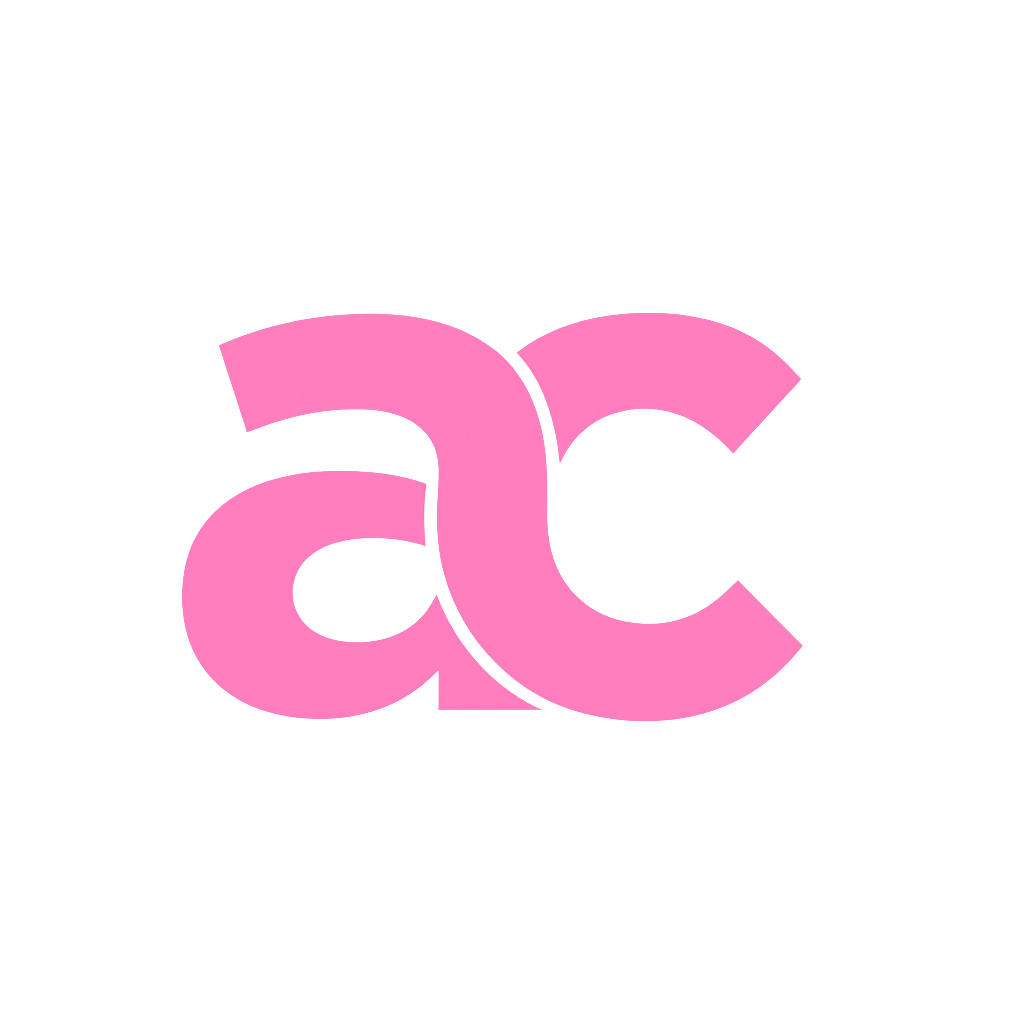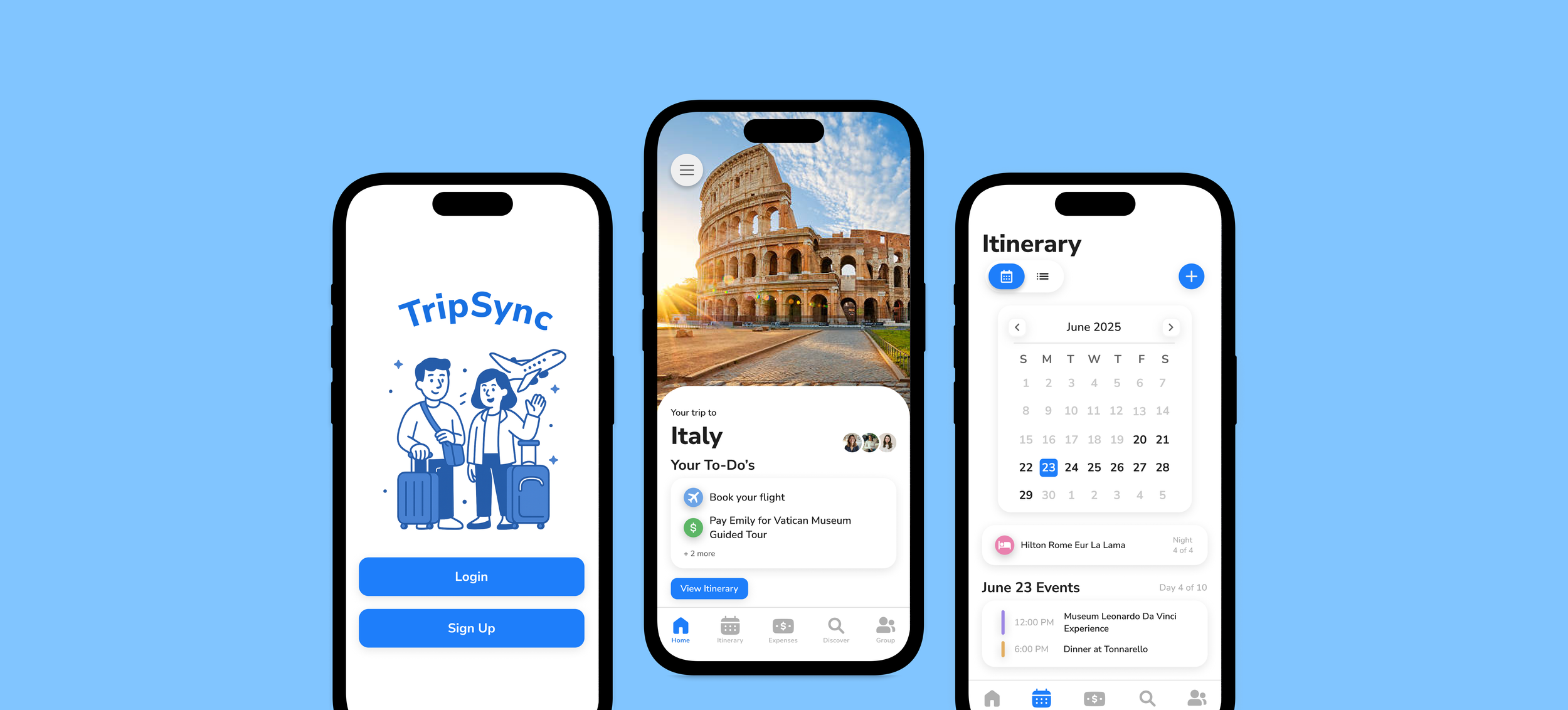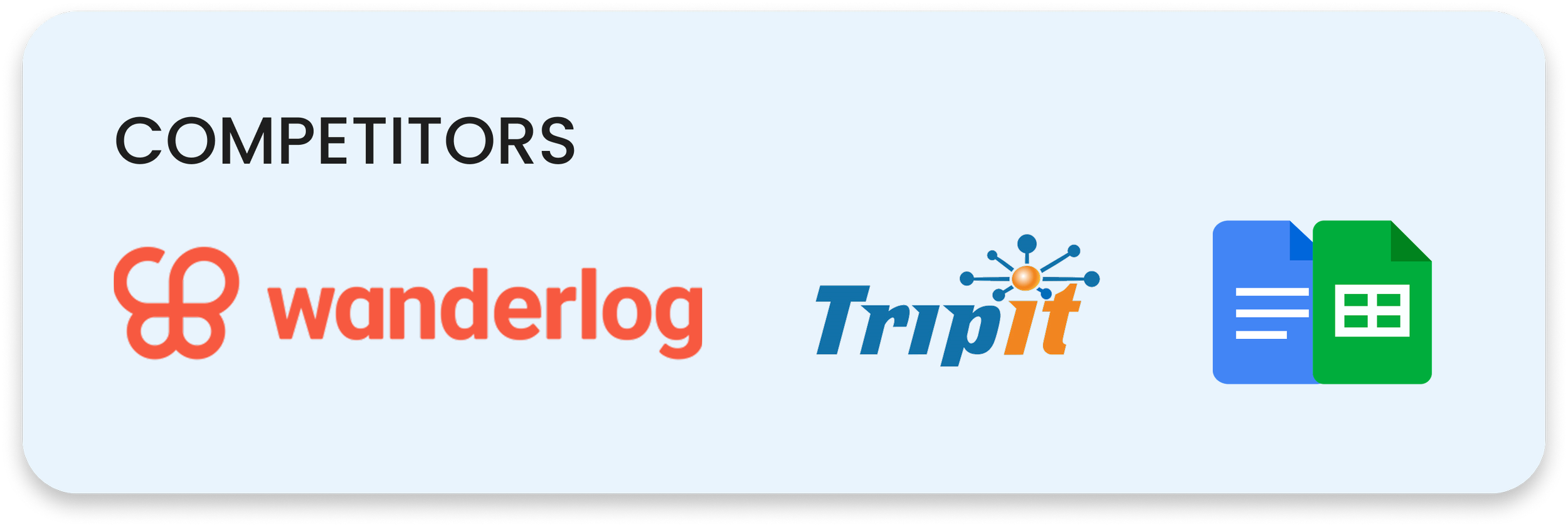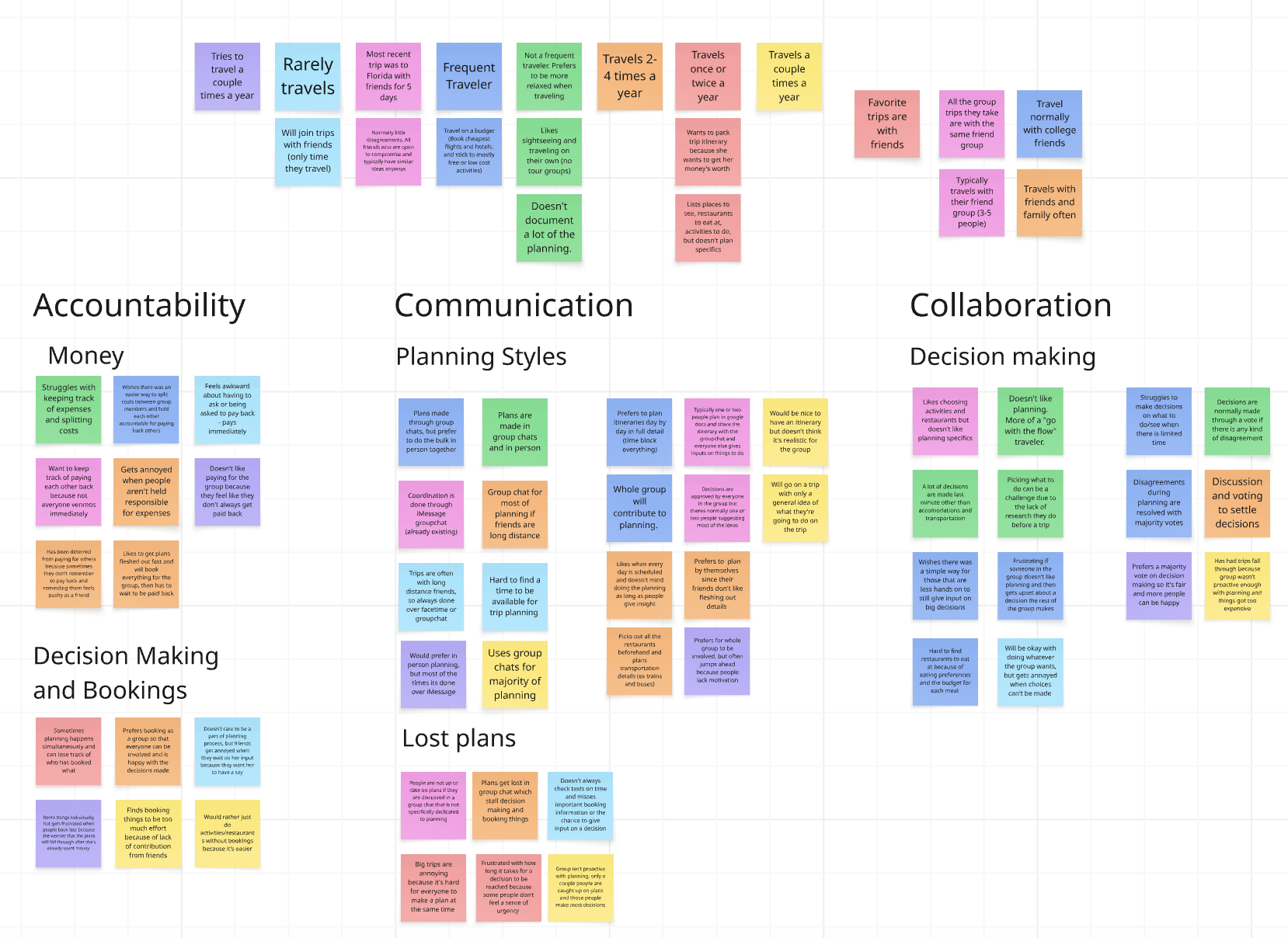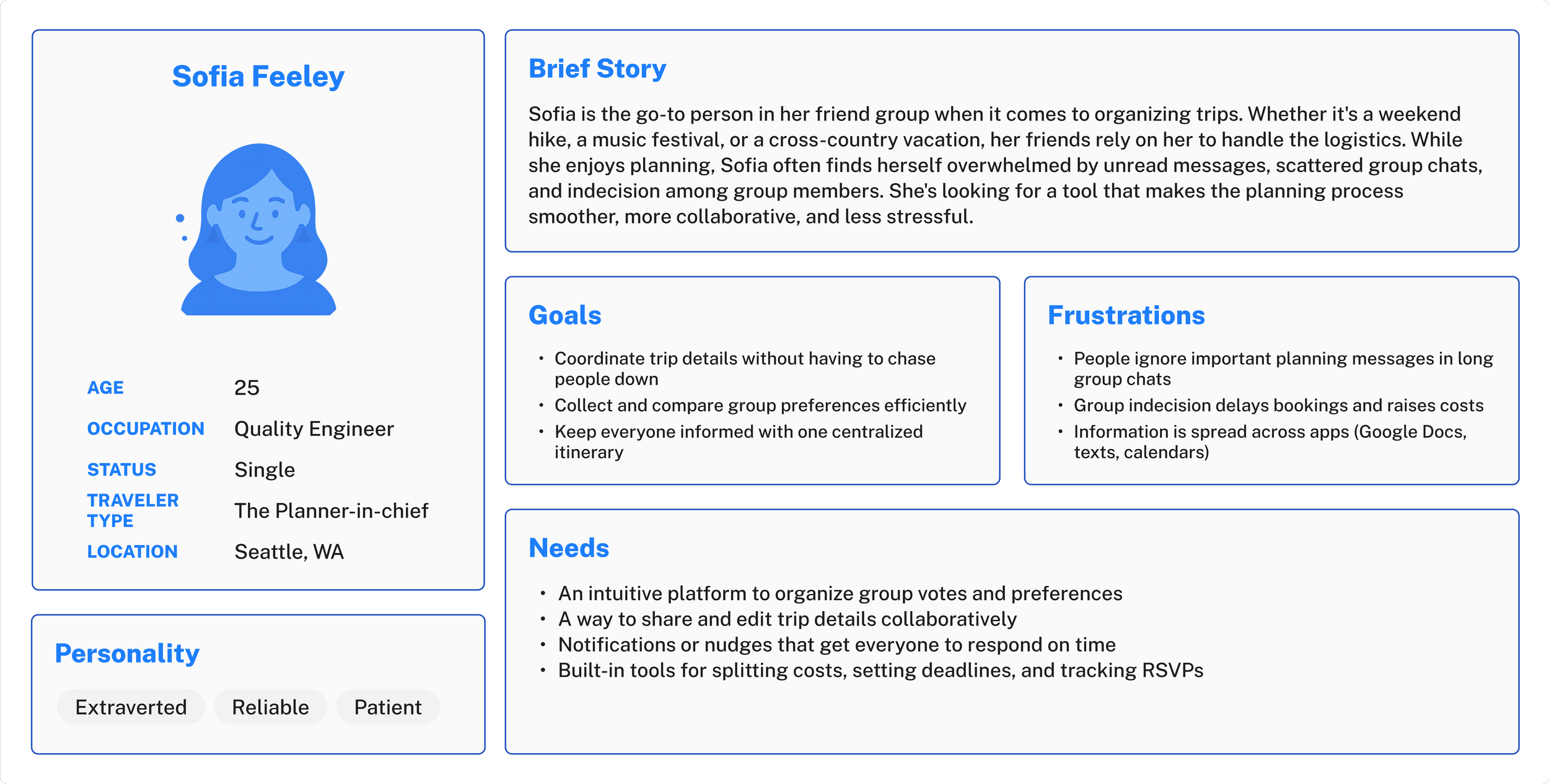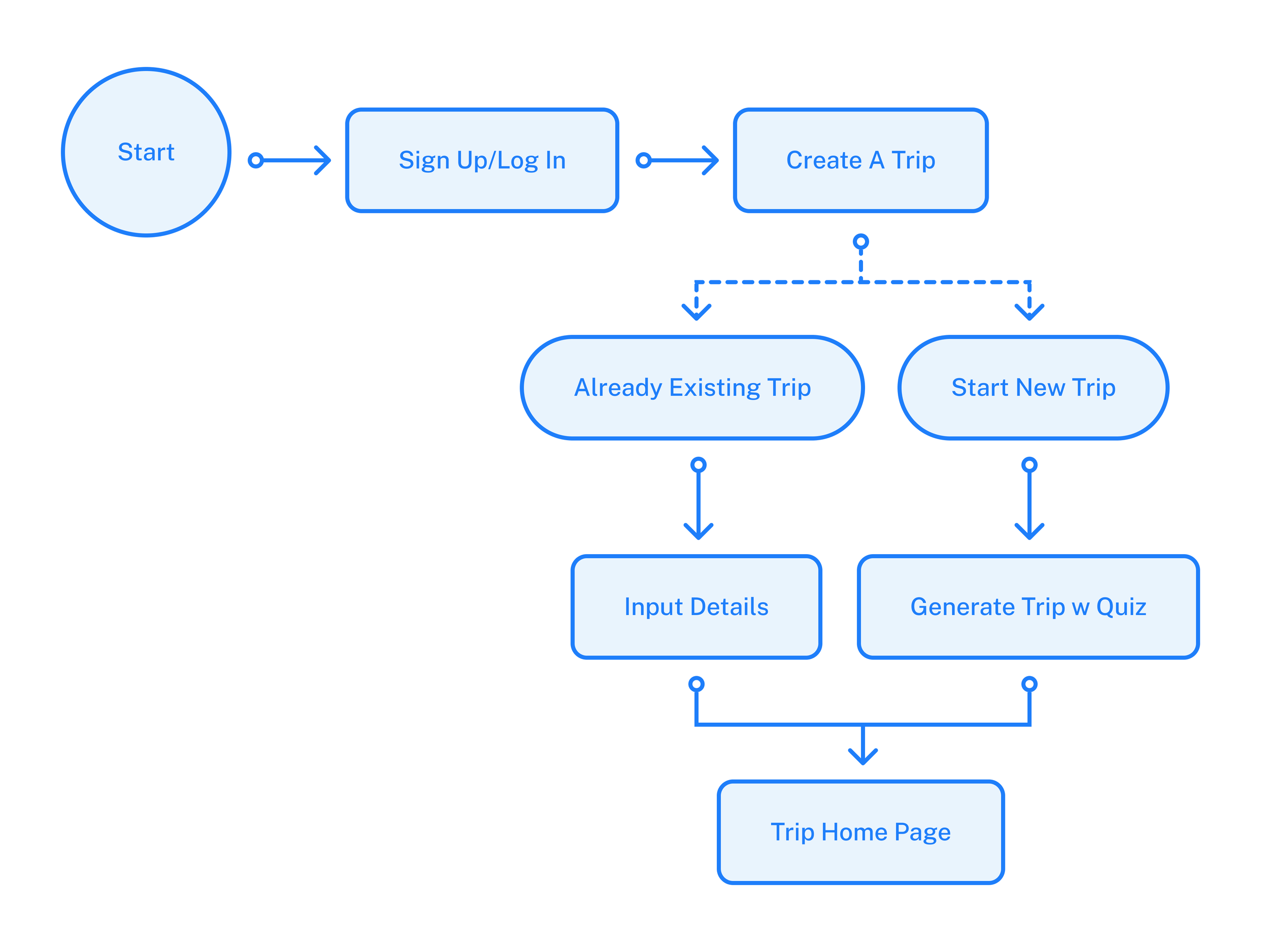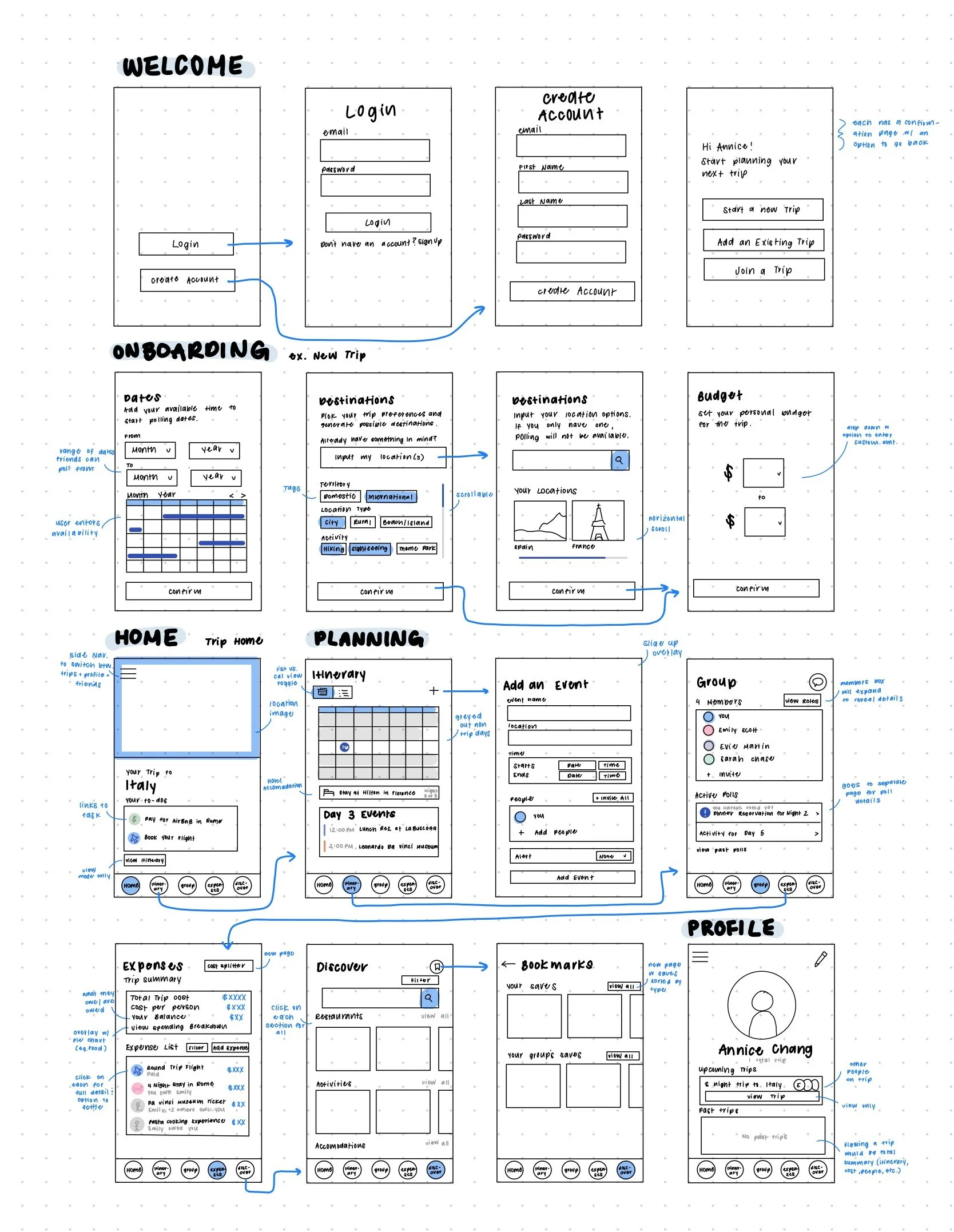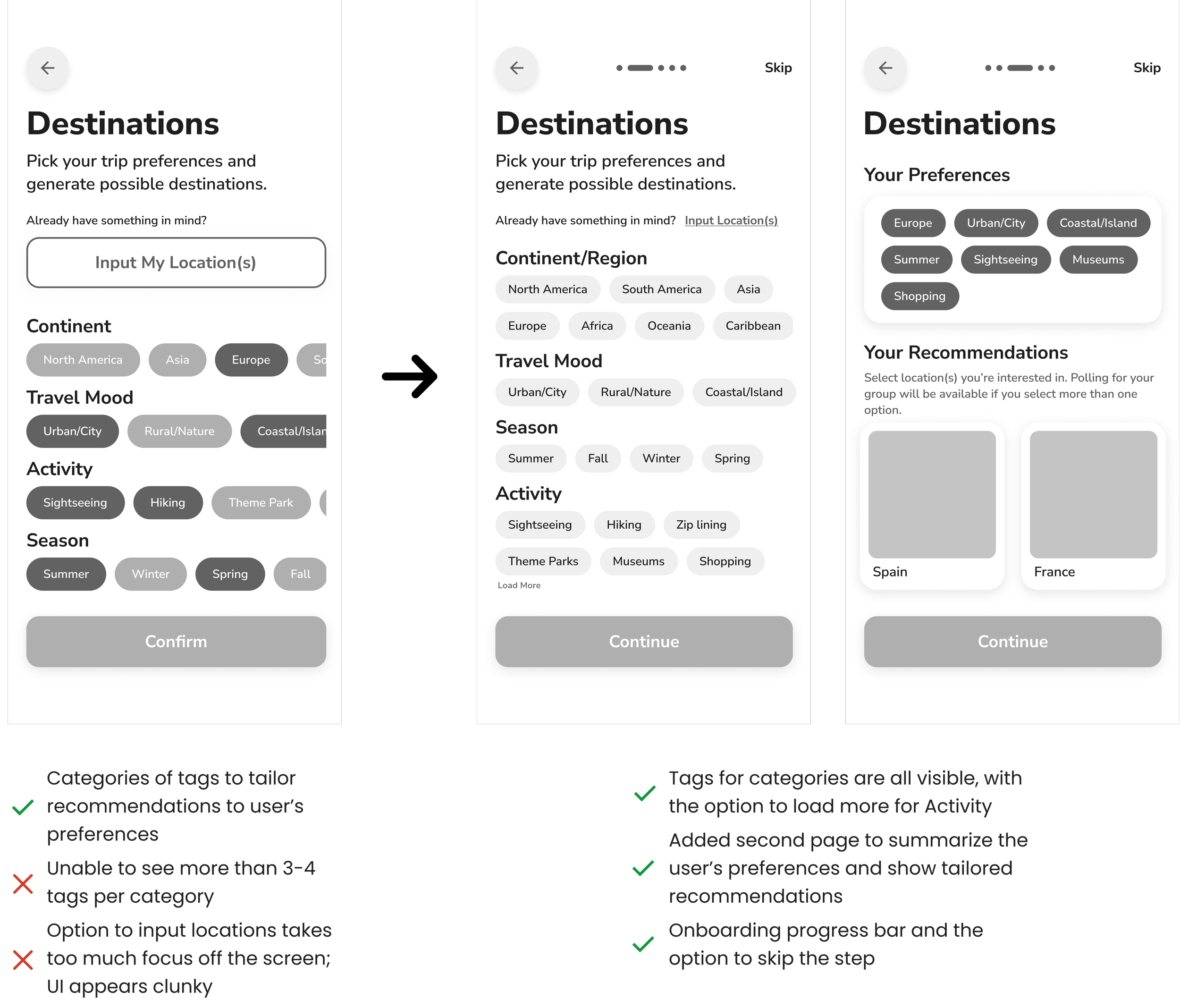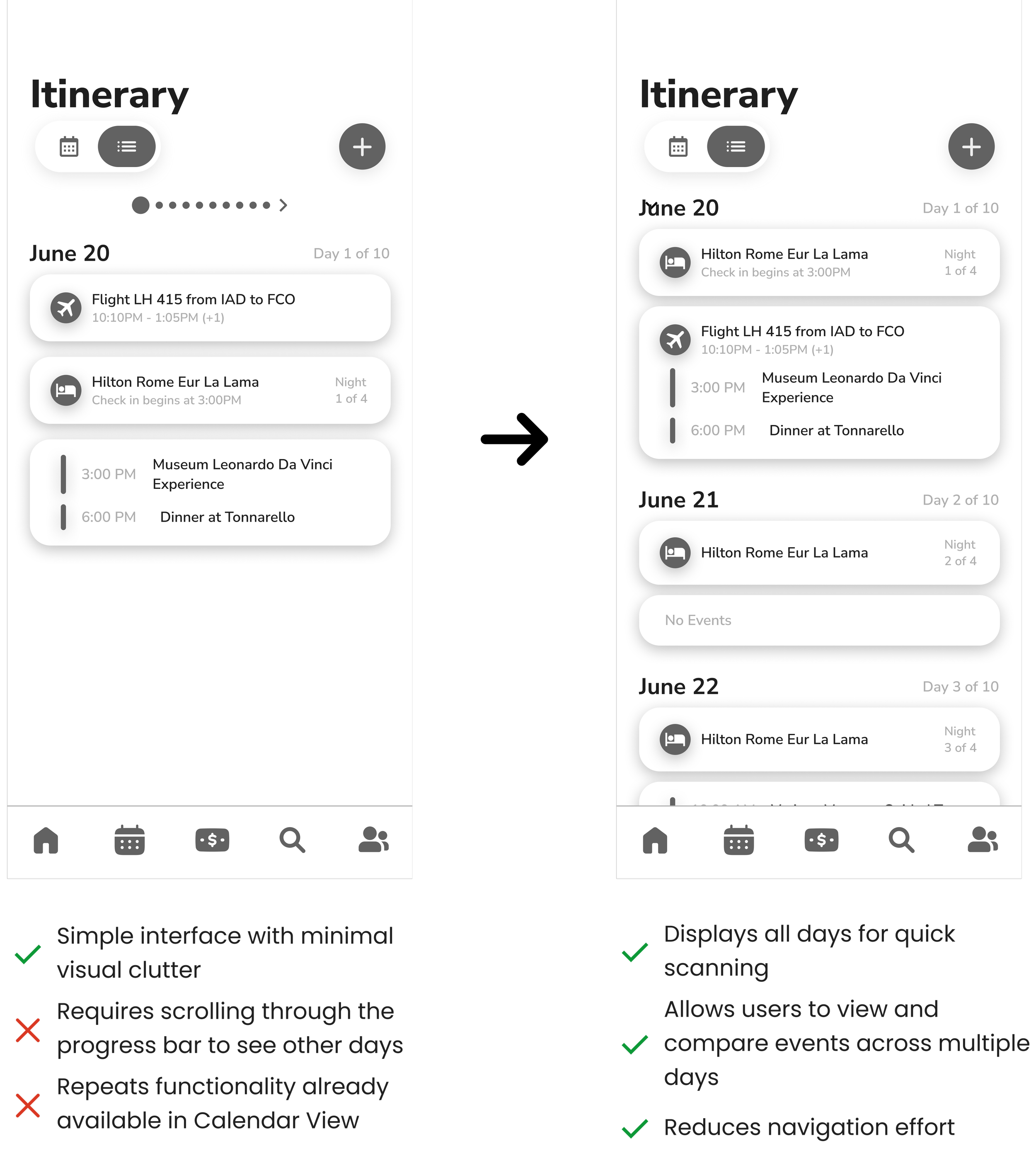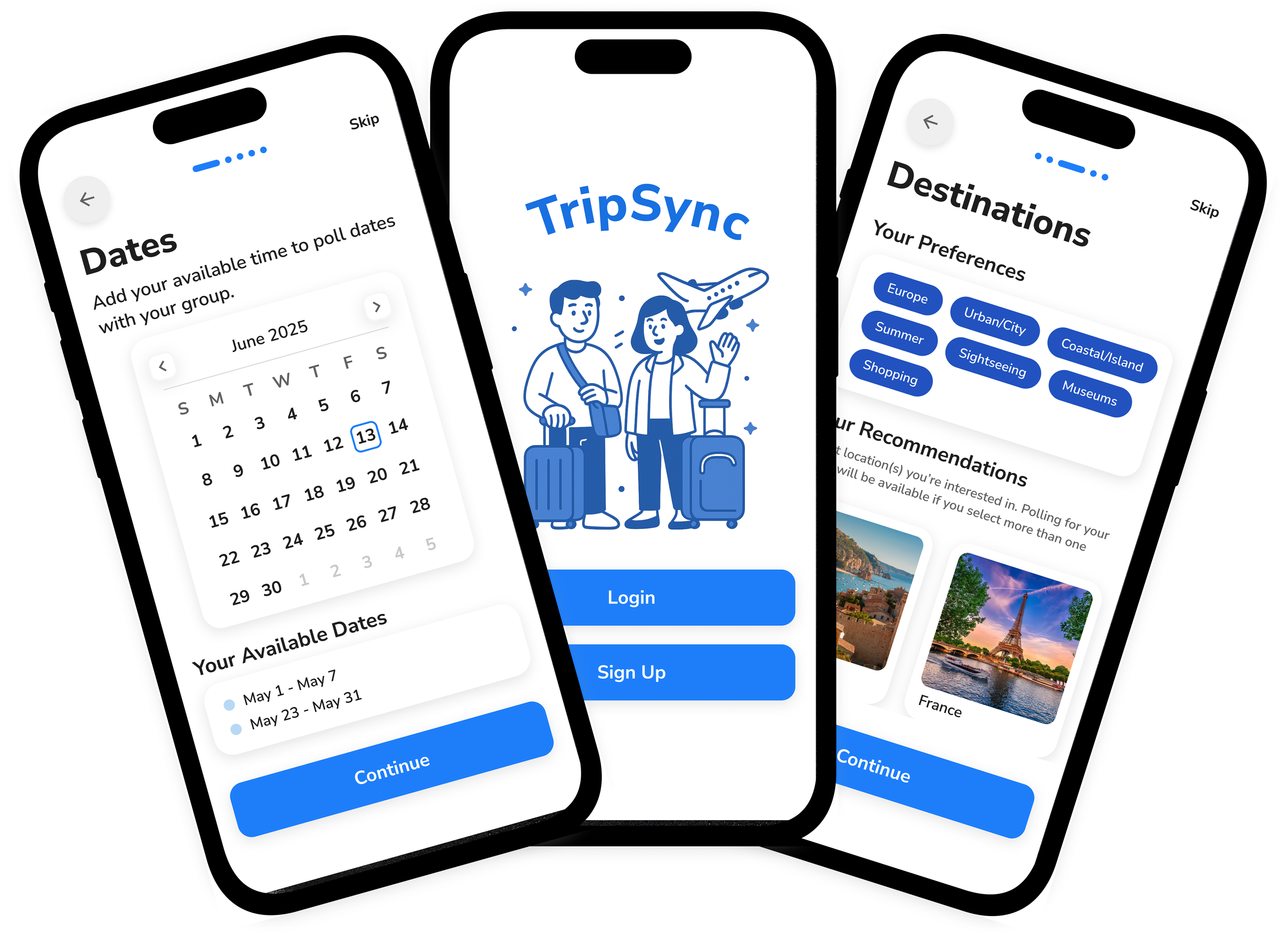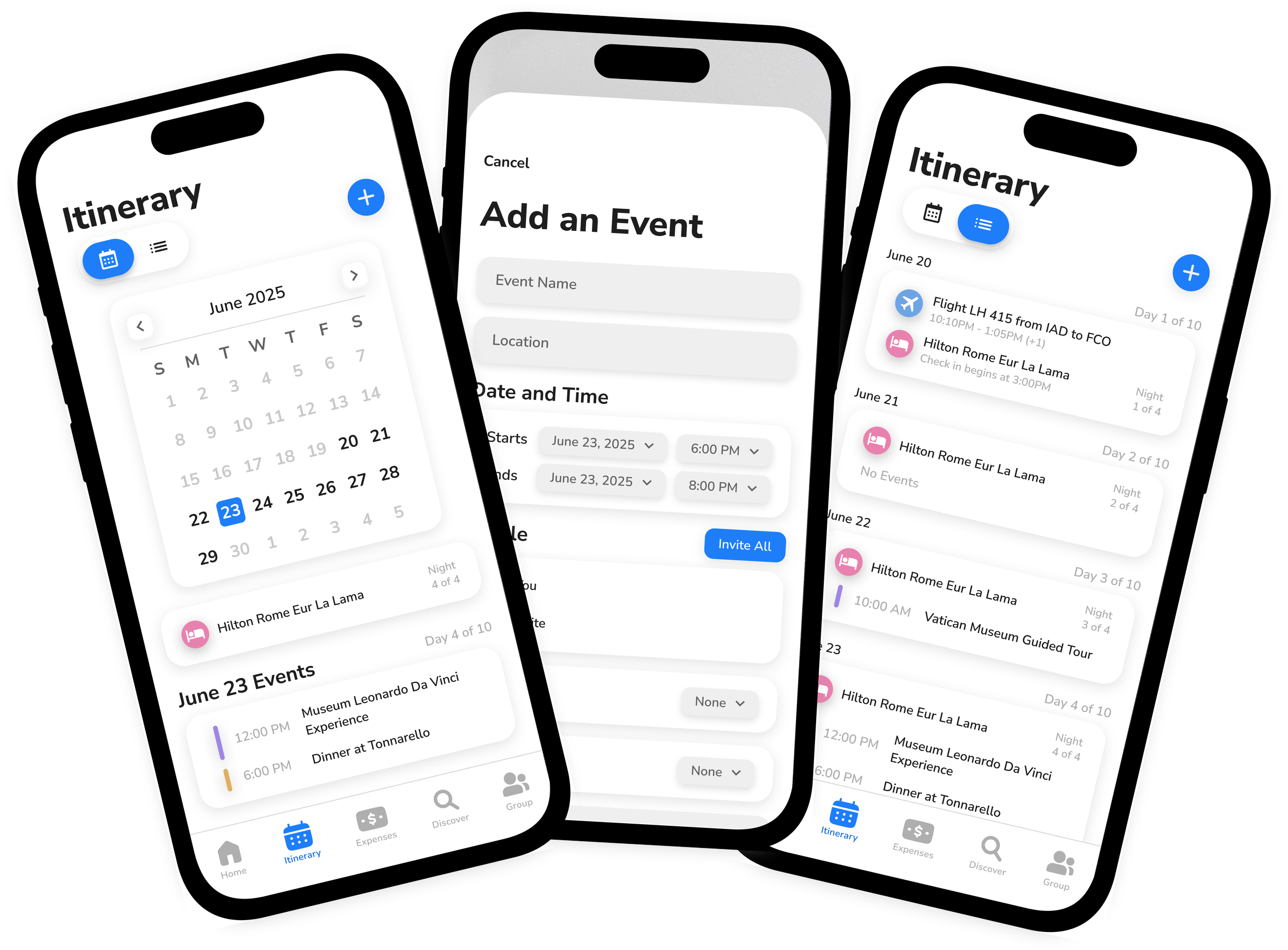TripSync
WHAT IS TRIPSYNC?
A collaborative travel planning app designed to simplify group trips from start to finish. Whether you're coordinating with two friends or ten, TripSync helps users draft, organize, and refine trip plans together. From choosing destinations through polls to tracking shared expenses and itineraries, the app keeps everyone aligned.
ROLE
UX researcher, UX/UI designer
TEAM
Independent Project
TOOLS
Figma, Miro
THE PROBLEM
Planning group trips is often a frustrating and time-consuming experience.
Coordinating preferences, aligning schedules, deciding on destinations, and managing logistics like accommodations or shared expenses can quickly become overwhelming, especially when done across multiple messaging platforms and booking sites. Groups often struggle to reach consensus, leading to indecision, missed opportunities, or plans that don’t satisfy everyone.
THE SOLUTION
A platform that streamlines the group travel planning process by utilizing decision-making tools (voting, polling, and scheduling), offering shared itineraries, and facilitating collaborative trip organization in one place. The goal is to make group trip planning more inclusive, efficient, and enjoyable for everyone involved.
COMPETITOR ANALYSIS
What gaps or opportunities exist in current travel planning tools?
To better understand the landscape of group travel planning tools, I analyzed three key competitors and evaluated their strengths and limitations. This helped me identify common pain points across platforms and find opportunities for TripSync to deliver a more cohesive experience.
USER RESEARCH
Where does communication or coordination most often break down during trip planning?
Through user interviews and surveys, I aimed to uncover the specific moments where planning breaks down, whether it’s agreeing on dates, tracking expenses, or simply keeping everyone on the same page.
Before conducting interviews and surveys, I identified key target audiences to ensure that my research would address the needs, behaviors, and frustrations of the most relevant traveler types for TripSync.
To synthesize my findings from user interviews, I created an affinity diagram in Miro and grouped related observations into categories based on common themes.
This helped me identify core pain points and opportunities that would guide TripSync’s design direction. From this process, I uncovered four key insights that reflect the most important needs and behaviors of group travelers.
In analyzing user research, I developed two user personas that best embodied the target audience’s needs, frustrations, and goals.
IDEATION
Exploring key features that solve disorganized planning, unclear communication, and group coordination.
Noting key pain points, I created task flows for both the onboarding process and key in-app actions to visualize how users would navigate the app and interact with core features.
I then created low fidelity sketches to explore layout ideas and visualize how key features could come together. This step helped translate user needs into tangible interface concepts before moving into higher-fidelity design.
Building on the sketches, I developed mid-fidelity wireframes in Figma to establish structure, layout, and functionality. These wireframes served as the first detailed version of the interface prior to gathering user and peer feedback.
USER TESTING & ITERATION
Evaluating usability and gathering feedback to inform design improvements.
Initial user testing and peer feedback provided valuable insights into areas of confusion and opportunities for improvement. Based on this input, iterations were made to several mid-fidelity designs to enhance clarity and usability. Here are some of the pages I iterated on.
Start a New Trip - Destinations
When setting up a trip, users have the option to generate destination recommendations based on preferences they select using tags. The initial wireframe lacked functionality due to the size and horizontal scroll of the tags, which limited the visibility of tag options and made it hard for users to see what they’ve already selected. The page was iterated on to maximize visibility of the tags, and I designed a second page for users to view their selection and recommendations.
Itinerary - List View
Originally, the List View in the itinerary showed a single-day view to maintain an uncluttered interface. However, users found that scrolling through the progress bar to locate a specific day took unnecessary time, especially if the trip is long. Because the single-day view is already implemented within the Calendar view, users also wanted a way to see their entire trip at a glance. To address this, I redesigned the list view so that each day of the trip is displayed all on the same page sequentially, allowing users to easily scroll through all trip events.
Discover - Saves/Bookmarks
Users can turn to the Discover section of the app to search for activities, restaurants, and accommodations for the cities they’re visiting during their trip. They have the option to save their interests as well as view their group member’s saves. The initial design was too limited in details and there was opportunity to increase functionality.
FINAL DESIGN
After multiple rounds of wire framing, feedback, and refinement, I present the final design of TripSync, a solution for collaborative group travel planning.
Follow Onboarding Steps to Start a Trip
Whether you’re planning a new trip from scratch, adding existing trip plans, or joining someone's trip, TripSync’s onboarding flow makes it easy to set key details like dates, destination, budget, and group members, so everyone starts on the same page.
Manage Trip Expenses & Share Costs Seamlessly
View your trip’s expenses and your group’s spending breakdown. Log your transactions, choose who paid, and split the cost among selected members. Each person can mark their share as paid, and TripSync keeps track of what’s been settled and what’s still owed, so you can stay organized and avoid awkward money conversations.
Stay on Schedule with Your Group Itinerary
Keep your group organized with a shared schedule everyone can access. Toggle between calendar and list views to see each day’s plans, including events, restaurant reservations, accommodations, and transportation details.
View all your group’s saved spots and find common favorites between your saves and theirs. Easily filter by city or type to quickly find the best activities, restaurants, and accommodations for your trip.
Find Spots to Eat, Stay, and Play
Manage Group Communication and Make Decisions Easily
View all your travel companions, invite new members, and stay connected through direct messaging. Easily coordinate plans by creating and participating in polls, letting everyone vote on key decisions like where to eat, what activities to do, or which city to visit.
View the Figma file with all the wireframes and the full prototype of TripSync.
REFLECTION & NEXT STEPS
Designing TripSync from the ground up was a rewarding challenge that pushed me to think holistically about both functionality and user experience. Each iteration deepened my understanding of how thoughtful design can simplify and enhance group travel. Additionally, this project reaffirmed the importance of staying grounded in user feedback. From the way people wanted to vote on trip decisions to how they preferred to communicate with friends, every design decision was shaped by real needs.
Moving forward…
If time permits, I would love to further my user research and expand beyond college-aged students for feedback on TripSync. I would like to focus on a larger range of adults, as there may be features that TripSync could benefit from to appeal to more types of travelers. Some of the features I currently have in mind include
Calendar Integration
Syncing with Google Calendar or Apple Calendar to automatically add already planned events, reservations, flights, and bookings will make the itinerary less of a hassle to set up.
Local Discovery
Upgrade the Discover feature by including "Trending Now" or “Locals Love” sections and tags to surface popular or hidden gem spots.
AI-Powered Suggestions
Use AI to suggest itineraries, polls, or saved spots based on group preferences or past trips, as well as generate daily schedules based on distance, hours of operation, and weather.
